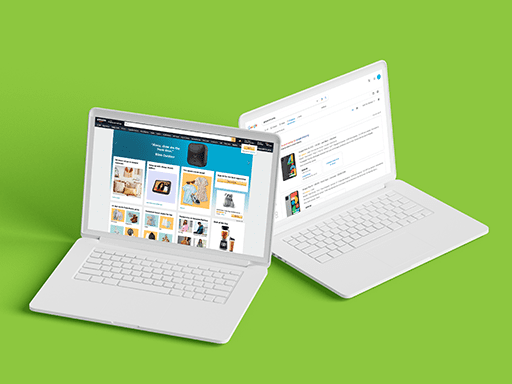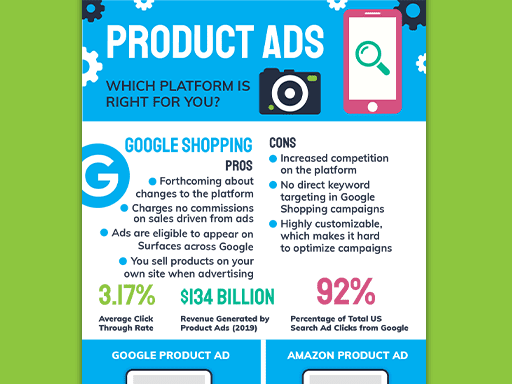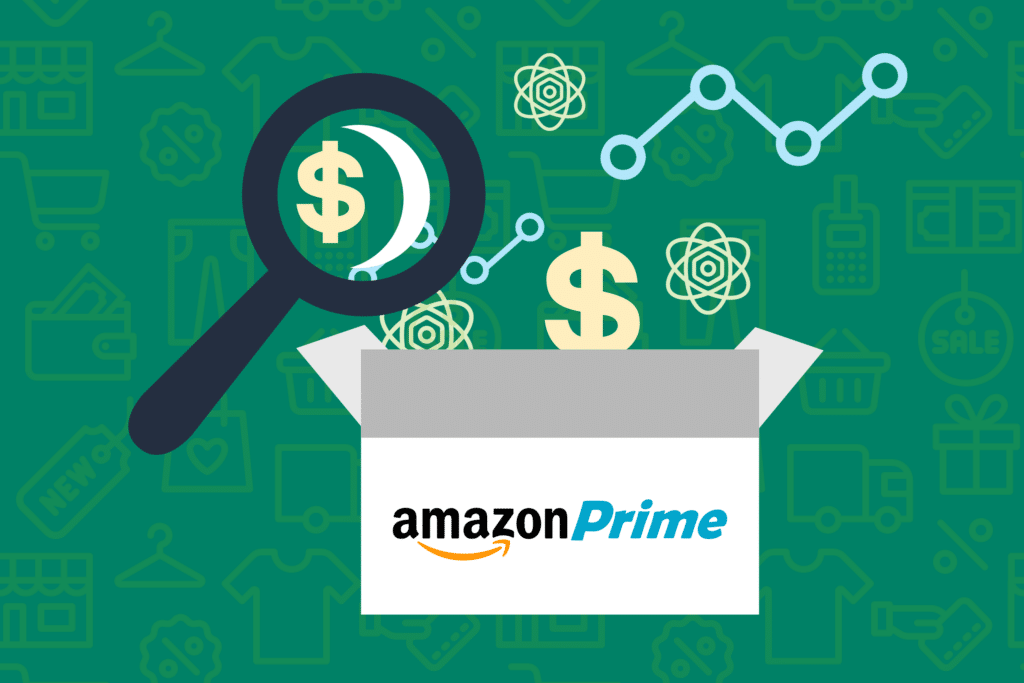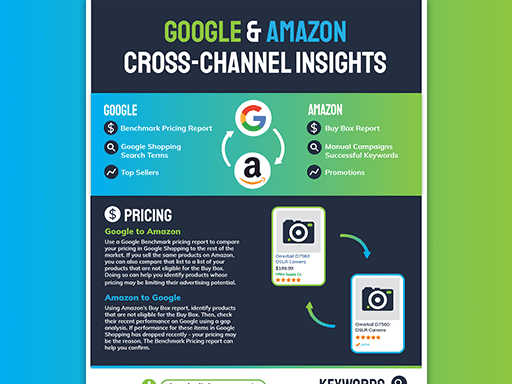Whether you primarily sell on Google Shopping or on Amazon, you’ve probably wondered, “Is this the right platform for my business?” Google Shopping vs Amazon Product Ads: who’s the winner? One size doesn’t fit all. There are pros and cons to each platform. Let’s take a look at each kind of advertising, and see which is best for your products!

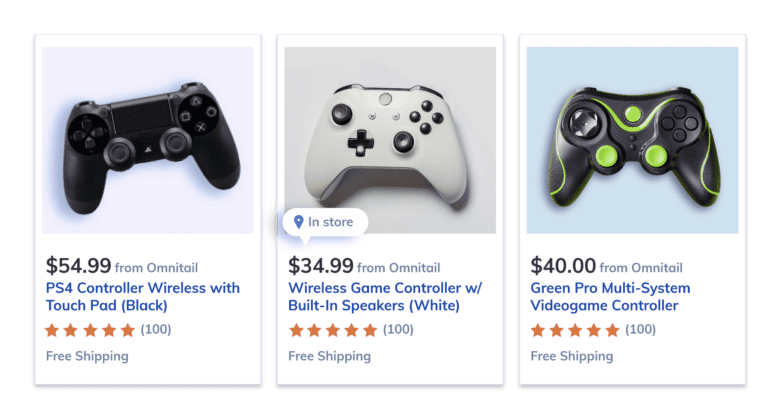
Should I advertise on Google Shopping?
Google Shopping has been around for a long time (almost as long as Google itself!), but it’s really taken off in the last five years. Now, it’s one of the largest ecommerce shopping platforms – and a must for online retailers.
Let’s weigh the pros and cons of advertising your products on Google Shopping:
Pros of Google Shopping
No Commission
One major advantage over Amazon ads is the lack of commission. Both platforms require advertisers to pay per click, but unlike Amazon, Google charges no commission on sales driven by ads. That’s extra margin you get to keep!
More Transparency Than Amazon
Google Shopping is much more transparent than Amazon, as well. Google tends to be much more forthcoming about changes to the platform, and has made much more information available via their documentation and their blog. As a result, it’s easier to design a strategy that works for you, and to anticipate how updates will impact your campaigns.
Promotion Extensions
Google Shopping also offers promotion extensions, so you can offer an extra incentive for customers to purchase. Promotions can include discounts, free items, or free shipping. Check out our guide to Google Shopping promotions!
Sell Products on Your Own Website
Finally, you sell products on your own site when advertising on Google Shopping. Amazon can cannibalize your site’s sales if you’re not careful – not an issue with Google Shopping!
Cons of Google Shopping
Increased Competition
Google Shopping does have some downsides. One is the increased competition on the platform, which has many more advertisers than Amazon does. This can make it really difficult to stand out, especially for smaller retailers.
Overly Customizable
Google Shopping is highly customizable, which is good — but it can make managing campaigns unwieldy. You need to optimize your product feed, resolve any lingering errors, and then build a logical, profitable campaign structure. After all of that, you need to manage bids to prevent excess spend and make sure you’re updating everything regularly.
Temperamental Targeting
Google Shopping campaign targeting can be temperamental. Because Google doesn’t allow direct keyword targeting in Google Shopping campaigns, you need to ensure that your products don’t waste ad spend on irrelevant search terms. A profit-driven strategy based on segmentation according to query intent can help – check out this ebook to see how!

Should I advertise on Amazon?
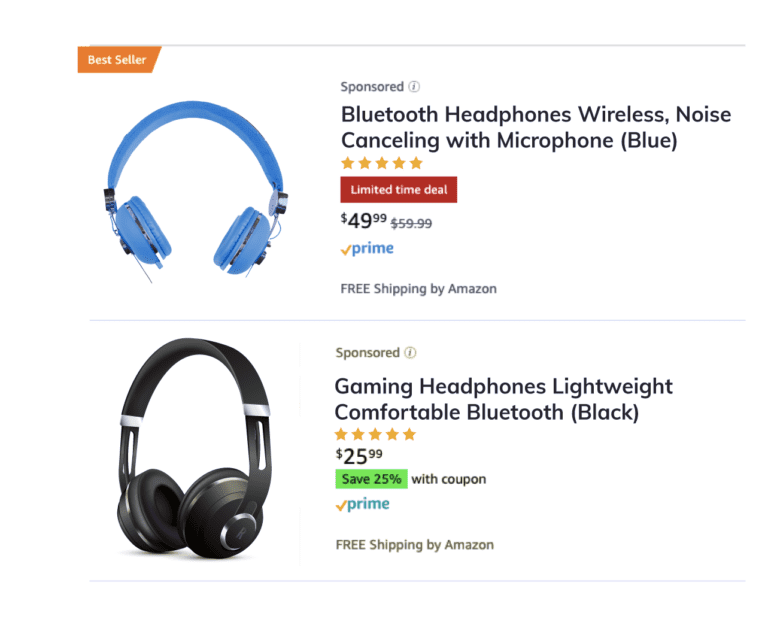
Amazon is the other ecommerce elephant in the room! With more than $280 billion in sales last year alone, Amazon seems like an obvious choice for retailers looking to move beyond their current website sales.
Amazon’s native ads platform, Amazon Advertising, offers sellers the chance to run product ads across the site, including in search results and on individual product pages.
Like Google, there are pros and cons to advertising on Amazon:
Pros of Amazon Advertising
Less Advertisers, Cheaper Clicks
Like Google, Amazon has some upsides. It’s a smaller platform in terms of number of advertisers, so you may be able to get a foothold in the market before other competitors. Depending on your products, Amazon clicks might even be cheaper than on Google Shopping (although you need to factor in commission – more on that later!)
Placement Options
Because Amazon Ads takes place on the same platform as product sales, there are some unique placement options. Your ads can appear not only in search results, but on the detail pages for competitors’ products. This is obviously a huge advantage. You can put your products in front of not only people who are looking for products like yours, but people who are actively considering your competitor’s products.
Shipping and Brand Equity
Amazon also facilitates billions of dollars every year in sales. Customers often choose Amazon because of their 2-day shipping and solid brand equity. If you are already listing products on Amazon, advertising is a great way to expand your store’s reach beyond Google Shopping.
Keyword Targeting
Amazon allows you to target specific keywords and search terms in Sponsored Product Campaigns. This means you can put your products at the top of highly-relevant product searches. Google Shopping ads, on the other hand, offer no direct keyword targeting, only indirect targeting using negative keywords.
Cons of Amazon Advertising
Commission
This is one of the biggest discrepancies between Google and Amazon, from a profit-driven perspective. Amazon charges a commission on all sales, usually around 15%. This can really take a chunk out of profit, especially if other costs are equal to Google Shopping!
Less Transparency
Amazon’s platform doesn’t have as much transparency as Google Shopping, meaning changes often catch advertisers unaware. This has caused retailers – big and small – to abandon the platform due to its unpredictability. There also isn’t as much documentation available, so strategy is often trial and error.
Time Consuming
The platform is clunkier, as well. Google has a bulk editor, but Amazon doesn’t – meaning you need to build each campaign individually, and then add products and set bids. If you have lots of products – that time really adds up!
Amazon’s lack of a bulk editor extends to adjustments, as well. You technically can update bids using a bulk template, but it’s tricky and prone to failing. Changing everything in the UI is, again, a very manual process and takes a lot of time! The last option (and the one we utilize at Omnitail) is API access. Using the API is highly technical, though, and probably not practical for most advertisers.
Limited Management Options
Compared to Google Shopping, Amazon has more limited options for management. The feed can’t be used to define attributes as it is on Google, and the query segmentation strategy we utilize for Google Shopping doesn’t translate to Amazon. To further complicate matters, Amazon Ads depends heavily on being able to capture “the buy box” which incorporates a number of factors from pricing to FBA eligibility.
Attribution
If you can get ads to run and find a way to manage them, Amazon attribution remains a struggle. It often takes a few days for all performance data to make it to the reports, and with Amazon’s limited 7-day attribution window, it can be difficult to make data-driven management decisions. This is especially true around big single-day sales like Prime Day, Black Friday, and Cyber Monday.

Should I use a profit-driven strategy?
Now, for the best part – you don’t really have to choose. It’s perfectly possible to run both Amazon Product and Google Shopping ads, and to see success across all of your campaigns!
The real key is to employ a profit-driven management strategy for both. To do that, a few things need to happen: you need to track costs at the SKU-level and build more solid campaigns.
Track Costs at the SKU-Level
For Google Shopping ads, this is best done in the product feed. Google recently began offering a dedicated product attribute for this information, but you can also use one of the custom labels as well.
On Amazon, this is a little trickier. You can’t necessarily place the cost of goods in the feed like you can with Google, but you still need to have an idea of the costs that are associated with each product. We’ll talk about how to incorporate this information in the next section.
In either case, make sure you’re including any other relevant costs as well, like shipping, royalties, or payment processing costs. Amazon campaigns should include any commission Amazon charges on your products, as well as any additional fees. The FBA program often has significantly higher fees than items that are fulfilled by the seller for instance.
The goal is to have as much information as possible about the impact of sales on your business, so you can make a truly informed decision about where to drive ad spend.
Build Solid Campaigns
The success of your Google Shopping and Amazon campaigns depends on your campaign structure. Each platform requires a bit of a different strategy, but there are some common elements.
One is product segmentation. By grouping together products with similar margin, you can ensure spend pushed to those ad groups has a roughly equal impact on your profit. On Amazon, we’re proponents of a very limited number of products per ad group (even one per ad group in some cases), so you need to segment much more narrowly. On Google, you can have larger ad groups for all but the most successful products, but we still recommend segmenting by at least a couple of other attributes.
By implementing these changes, you’ll be able to factor in all of the important attributes, and drive spend to the ad groups that are providing the most value for your business!

Whether you advertise on Amazon or Google Shopping (or both) — Omnitail can help you maximize the profitability of your ads. For a free analysis of your current campaigns, reach out today.

